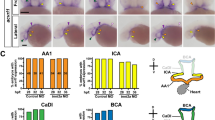Abstract
Increasing attention is being paid to the configuration and development of vascular structures and their possible correlations with physiological events. The study of angiogenesis in normal and pathological states as well as in the embryo and adult has provided new insights into the mechanism of vessel growth and organization of the vasculature. Various mathematical branching models have been developed. These constructions are mainly geometrical and only involve a branching phenomenon. We propose the use of a deterministic non-linear model based on physiological laws and hydrodynamics. Growth, branching and anastomosis, the three actual main events occurring in vascular growth, are included in this model. Space growth, including cells and vessels, is defined by a decreasing transformation. Space density and the length of new sprouts are controlled by a set of parameters. The conditions on these parameters are well established, which allows the production of realistic patterns.
Similar content being viewed by others
References
Arhaliass, A., G. Guiffant and J. Dufaux. 1991. L'apport d'une représentation ordonnée du réseau de microvaisseaux à la compréhension de son fonctionnement.Innovative Techniques Biol. Med. 12, 350–357.
Ausprunk, D. A. and J. Folkman. 1977. Migration and proliferation of endothelial cells in preformed and newly formed blood vessels during tumor angiogenesis.Microvasc. Res. 14, 53–63.
Back, L. H., T. K. Liem, E. Y. Kwack and D. W. Crawford. 1992. Flow measurements in a highly curved atherosclerotic coronary artery cast of man.J. Biomech. Eng. 114, 232–240.
Barnhill, R. L. and J. E. Wolf, Jr. 1987. Angiogenesis and the skin.J. Am. Acad. Dermatol. 16, 1226–1242.
Barnsley, M. F. and S. Demko. 1985. Iterated function systems and the global construction of fractals.Proc. Roy. Soc. London Ser. A 399, 243–275.
Bittner, H. R. 1991. Modelling of fractal vessel systems. InFractals in the Fundamental and Applied Sciences, H. O. Peitgen, J. M. Henriques and L. F. Penedo (Eds), pp. 59–70. New York: Elsevier Science Publishers.
Clark, E. R. and E. L. Clark. 1939. Microscopic observations on the growth of blood capillaries in the living mammal.Am. J. Anat. 64, 251–301.
Feder, J. 1988.Fractals. New York: Plenum Press.
Folkman, J. 1972a. Anti-angiogenesis: new concept for therapy of solid tumors.Ann. Surg. 175, 409–416.
Folkman, J. 1972b. Angiogenesis in psoriasis: therapeutic implications.J. Invest. Dermatol. 59, 40–43.
Folkman, J. 1985. Toward an understanding of angiogenesis: search and discovery.Perspect. Biol. Med. 29, 10–36.
Folkman, J. and M. Klagsbrun. 1987. Angiogenic factors.Science 235, 442–447.
Gottlieb, M. E. 1990. Modelling blood vessels: a deterministic method with fractal structure based on physiological rules.Proceedings of the 12th International Conference Of IEEE EMBS, pp. 1386–1387. New York: IEEE Press.
Gottlieb, M. E. 1991a. The VT model: a deterministic model of angiogenesis and biofractals based of physiological rules.Proceedings of the IEEE 17th Annual Northeast Bioengineering Conference, pp. 38–39. New York: IEEE Press.
Gottlieb, M. E. 1991b. Vascular networks: fractal anatomies from non-linear physiologies.IEEE Eng. Med. Bio. Mag. 13(5), 2196–2197.
Henkind, P. 1978. Ocular neovascularization. The Krill Memorial Lecture.Am. J. Ophthalmol. 85, 287–301.
Hudlicka, O. 1984. Development of microcirculation: capillary growth and adaptation. InHandbook of Physiology, E. M. Renkin, C. C. Michel and S. R. Geiger (Eds), pp. 165–216. Bethesda, MD: American Physiological Society.
Ingber, D. E. 1991. Control of capillary growth and differentiation by extracellular matrix. Use of tensegrity (tensional integrity) mechanism for signal processing.Chest 99, 34S-40S.
Kiani, M. and A. Hudetz. 1991. Computer simulation of growth of anastomosing microvascular networks.J. Theor. Biol. 150, 547–560.
Landini, G. and G. Misson. 1993. Simulation of corneal neo-vascularization by inverted diffusion limited aggregation.Invest. Ophthalmol. Visual Sci. 34(5), 1872–1875.
Liotta, L., G. M. Saidel and J. Kleinerman. 1977. Diffusion model of tumor vascularization and growth.Bull. Math. Biol. 39, 117–128.
Mandelbrot, B. B. 1982.The Fractal Geometry of Nature. San Francisco: Freeman.
Phillips, G. D., R. A. Whitehead and D. R. Knighton. 1991. Initiation and pattern of angiogenesis in wound healing in the rat.Am. J. Anat. 192, 257–262.
Quemada, D., J. Dufaux and P. Flaud. 1993. L'hydrodynamique du sang.La Recherche 254, 584–590.
Rodkiewicz, C. M., J. Centkowski and S. Zajac. 1992. On the subclavian steal syndrome. In vitro studies.J. Biomech. Eng. 114, 527–532.
Ryan, T. J. 1970. Factors influencing the growth of vascular endothelium in the skin.Br. J. Dermatol. 82(S5), 99–111.
Stokes, C. L. and D. A. Lauffenburger. 1991. Analysis of the roles of microvessel endothelial cell random motility and chemotaxis in angiogenesis.J. Theor. Biol. 152, 377–403.
Thrakal, K. W., W. H. Goodson and T. K. Hunt. 1979. Stimulation of wound blood vessel growth by wound macrophages.J. Surg. Res. 26, 430–436.
Vicsek, T. 1989.Fractal Growth Phenomena. New York: World Scientific Publishing Co.
Waxman, A. M. 1981. Blood vessel growth as a problem in morphogenesis: a physical theory.Microvasc. Res. 22, 32–42.
Wolf, J. E., Jr. 1989. Angiogenesis in normal and psoriatic skin.Lab. Invest. 61, 139–142.
Xu, X. Y., M. W. Collins and C. J. H. Jones. 1992. Flow studies in canine artery bifurcations using a numerical simulation method.J. Biomech. Eng. 114, 504–511.
Zawicki, D. F., K. J. Rakesh, G. W. Schmid-Schoenbein and S. Chien. 1981. Dynamics of neovascularization in normal tissue.Microvasc. Res. 21, 27–47.
Author information
Authors and Affiliations
Rights and permissions
About this article
Cite this article
Nekka, F., Kyriacos, S., Kerrigan, C. et al. A model of growing vascular structures. Bltn Mathcal Biology 58, 409–424 (1996). https://doi.org/10.1007/BF02460590
Received:
Issue Date:
DOI: https://doi.org/10.1007/BF02460590




